Differential Expression of Motivational Stimulus Properties by Dopamine in Nucleus Accumbens Shell versus Core and Prefrontal Cortex
- PMID: 12040078
- PMCID: PMC6758788
- DOI: 10.1523/JNEUROSCI.22-11-04709.2002
Differential Expression of Motivational Stimulus Properties by Dopamine in Nucleus Accumbens Shell versus Core and Prefrontal Cortex
Abstract
The response of extracellular dopamine (DA) and its relationship to motivational valence (positive or negative) and novelty of motivational stimuli was investigated by brain microdialysis in the nucleus accumbens (NAc) shell and core and prefrontal cortex (PFCX) of rats. Stimuli were elicited by intraoral infusion of 20% sucrose, sucrose plus chocolate, quinine, and NaCl solutions, feeding of a palatable food (Fonzies), or smelling of a predator (red fox) urine. Sucrose elicited appetitive reactions and increased DA in the PFCX but not in the NAc shell. An unfamiliar appetitive taste such as that of sweet chocolate and Fonzies, increased DA in all three areas. Habituation of the stimulatory DA response to intraoral chocolate or to Fonzies feeding was observed in the NAc shell after a single pre-exposure to the same taste or food; no habituation was observed in the NAc core nor in the PFCX. Aversive taste stimuli (quinine, saturated NaCl solutions) rapidly increased DA in the PFCX and in the NAc core, and this response did not undergo one-trial habituation. In the NAc shell, instead, no effect (10 min exposure) or a delayed, transitory increase of DA (5 min exposure) sensitive to one-trial habituation was obtained in response to the aversive taste (quinine and saturated NaCl) or olfactory (red fox urine) stimuli. These observations indicate that DA responsiveness is an integrated function of the motivational valence and novelty of stimuli in the NAc shell and an expression of generic motivational value in the NAc core and PFCX.
Figures




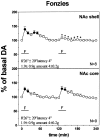
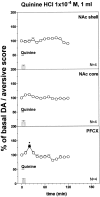
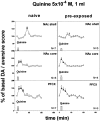


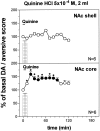

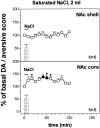
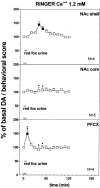

Similar articles
-
Influence of morphine sensitization on the responsiveness of mesolimbic and mesocortical dopamine transmission to appetitive and aversive gustatory stimuli.Psychopharmacology (Berl). 2011 Aug;216(3):345-53. doi: 10.1007/s00213-011-2220-9. Epub 2011 Feb 22. Psychopharmacology (Berl). 2011. PMID: 21340470
-
Lesion of medial prefrontal dopamine terminals abolishes habituation of accumbens shell dopamine responsiveness to taste stimuli.Eur J Neurosci. 2013 Feb;37(4):613-22. doi: 10.1111/ejn.12068. Epub 2012 Dec 6. Eur J Neurosci. 2013. PMID: 23216547
-
Modulation of feeding-induced activation of mesolimbic dopamine transmission by appetitive stimuli and its relation to motivational state.Eur J Neurosci. 1999 Dec;11(12):4389-97. doi: 10.1046/j.1460-9568.1999.00843.x. Eur J Neurosci. 1999. PMID: 10594666
-
Habituation of the responsiveness of mesolimbic and mesocortical dopamine transmission to taste stimuli.Front Integr Neurosci. 2014 Mar 4;8:21. doi: 10.3389/fnint.2014.00021. eCollection 2014. Front Integr Neurosci. 2014. PMID: 24624065 Free PMC article. Review.
-
Dopamine and drug addiction: the nucleus accumbens shell connection.Neuropharmacology. 2004;47 Suppl 1:227-41. doi: 10.1016/j.neuropharm.2004.06.032. Neuropharmacology. 2004. PMID: 15464140 Review.
Cited by
-
Stress-induced anhedonia is associated with hypertrophy of medium spiny neurons of the nucleus accumbens.Transl Psychiatry. 2013 Jun 4;3(6):e266. doi: 10.1038/tp.2013.39. Transl Psychiatry. 2013. PMID: 23736119 Free PMC article.
-
Regulation of anxiety and initiation of sexual behavior by CREB in the nucleus accumbens.Proc Natl Acad Sci U S A. 2005 Jun 7;102(23):8357-62. doi: 10.1073/pnas.0500587102. Epub 2005 May 27. Proc Natl Acad Sci U S A. 2005. PMID: 15923261 Free PMC article.
-
Caffeine Modulates Food Intake Depending on the Context That Gives Access to Food: Comparison With Dopamine Depletion.Front Psychiatry. 2018 Sep 6;9:411. doi: 10.3389/fpsyt.2018.00411. eCollection 2018. Front Psychiatry. 2018. PMID: 30237771 Free PMC article.
-
Exposure to cues associated with palatable food reward results in a dopamine D₂ receptor-dependent suppression of evoked synaptic responses in the entorhinal cortex.Behav Brain Funct. 2013 Oct 4;9:37. doi: 10.1186/1744-9081-9-37. Behav Brain Funct. 2013. PMID: 24093833 Free PMC article.
-
Involvement of the cannabinoid CB1 receptor in modulation of dopamine output in the prefrontal cortex associated with food restriction in rats.PLoS One. 2014 Mar 14;9(3):e92224. doi: 10.1371/journal.pone.0092224. eCollection 2014. PLoS One. 2014. PMID: 24632810 Free PMC article.
References
-
- Abercrombie ED, Keefe KA, Di Frischia DS, Zigmond MJ. Differential effect of stress on in vivo dopamine release in the striatum, nucleus accumbens and medial frontal cortex. J Neurochem. 1989;52:1655–1658. - PubMed
-
- Bassareo V, Di Chiara G. Differential responsiveness of DA transmission to food-stimuli in nucleus accumbens shell/core compartment. Neuroscience. 1999a;89:637–641. - PubMed
-
- Bassareo V, Di Chiara G. Modulation of feeding-induced activation of mesolimbic dopamine transmission by appetitive stimuli and its relation to motivational state. Eur J Neurosci. 1999b;11:4389–4397. - PubMed
-
- Bassareo V, Tanda G, Petromilli P, Giua C, Di Chiara G. Non-psychostimulant drugs of abuse and anxiogenic drugs activate with differential selectivity dopamine transmission in the nucleus accumbens and in the medial prefrontal cortex of the rat. Psychopharmacology. 1996;124:293–299. - PubMed
Publication types
MeSH terms
Substances
LinkOut - more resources
Full Text Sources
Other Literature Sources
